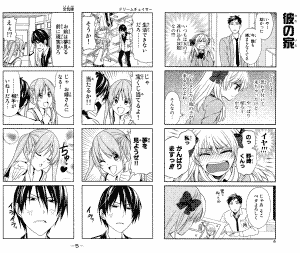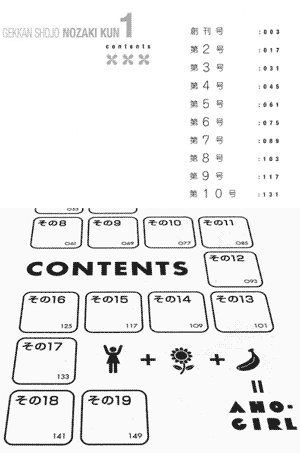In English, yonkoma, or 4 koma, means a "four-panel manga," in Japanese: yon-koma manga 4コマ漫画. These four panel comics are rather unique for a couple of reasons, including the fact that they're read differently from your typical manga.
Manga: Gekkan Shoujo Nozaki-kun 月刊少女野崎くん (Volume 1)
Types
There are two common types of yonkoma: the bonus yonkoma, and the yonkoma series.
A yonkoma series is a manga series that's entirely composed of four panel strips. When people say "that manga is a yonkoma" in English, they refer to this. Examples of this includes K-on! けいおん!, Azumanga Daioh あずまんが大王, and Gekkan Shoujo Nozaki-kun 月刊少女野崎くん.
A bonus yonkoma is a four panel strip included as a bonus, as an omake おまけ, in a tankoubon 単行本 volume of a manga series that's otherwise not in the four panel format. Typically, there'll be a few yonkoma at the end of the volume, but sometimes there's one at the start or between chapters.
How to Read
Typically, a yonkoma manga is read from top to bottom, right to left.
It's necessary to say this because a yonkoma manga typically has two strips side by side, forming two columns, in a layout that looks like you could read it from right to left instead, which is what you would do with a normal manga, but the correct way is from top-right to bottom-right first.
Some pages have different layouts. In particular, when a large panel covers the top half or bottom half of a page, the remaining four panels are still read top to bottom. Exceptionally, if the large panel is in the middle, you read the top row first, the middle panel, then the bottom row.
Format
A yonkoma is a "four panel" comic strip. The fourth and last panel of the strip has its punchline, but there's actually a pretty standardized convention for the purpose of each one of the four panels. It's called:
- ki-shou-ten-ketsu
起承転結
Introduction, development, turn and conclusion.
In a typical yonkoma strip, the first panel introduces a situation, the second panel elaborates it further, the third panel has a twist, and the fourth panel has a joke, retort, or reaction.
Variation
Although yonkoma means four panel, a yonkoma series isn't necessarily composed entirely of four panel strips. Some strips may have three panels instead. Some pages have five panels.
In some cases, a yonkoma series will have a segment that reads like a normal manga with panels in random places and sizes for a few pages, telling a story, before returning to the four panel format.
Strip Titles
Besides the four panels, a yonkoma strip optionally has a title, typically above its first panel. This varies from series to series. Some series don't have strip titles, others have titles in all strips except in pages with large panels.
Manga: Azumanga Daioh あずまんが大王 (Volume 1)
- Context: two different yonkoma series.
- The series at left, K-on!, doesn't have strip titles.
- The series at right, Azumanga Daioh, has strip titles.
- The first strip, at right, is titled nadenade なでなで, "pat pat." It's about a girl patting a cat.
- The second strip, at left, is titled itai いたい, "[it hurts]," because the cat bit the girl's hand.
Single and Double Column
Some yonkoma series have each page contain a single strip with four wide panels, while other series prefer square panels in a two-column page layout.
Manga: Gekkan Shoujo Nozaki-kun 月刊少女野崎くん (Volume 1)
- Context: two different yonkoma series.
- The series at left, Aho Girl, uses a two column layout. Observe that a same turn of events was repeated across adjacent strips, with the character making an even angrier reaction in the second (leftmost) strip.
- The series at right, Gekkan Shoujo Nozaki-kun, uses a single column layout. Observe that the panels are wider, and that the strip title is unusually at the right side of the first panel, rather than above it.
Serialization
Usually, a yonkoma series is serialized in a magazine together with normal manga.
4コマ誌
A yon-koma-shi 4コマ誌, "yonkoma magazine," is a magazine that publishes only yonkoma manga, and won't contain a normal, non-yonkoma manga.
An example of yon-koma-shi is the magazine where K-on! was serialized, Manga Time Kirara まんがタイムきらら.
Chapters
A single chapter of a yonkoma series contains multiple yonkoma strips.
To clarify: a single strip isn't a whole yonkoma chapter. It doesn't matter if the strip has a title or not.
If a yonkoma series is serialized monthly in a magazine, that means every month there will be a whole new "chapter" of the series with around the same number of pages as a normal manga series.
In a normal manga, a chapter tells a fragment of a story, or even a whole story, one page always leading to the next. It would never make sense to take a page of one chapter and switch it for the page of another chapter, as that would mess with the sequence of events.
In a yonkoma manga, a chapter is typically just a collection of tiny stories, each story having four panels each. The start and end of the chapter may be special, but the middle is mostly random.
For example, in Azumanga Daioh, each chapter is a month, such that after 12 months a whole year has passed in the series. Besides this temporal aspect, there isn't much reason why a strip from chapter 1 couldn't have been in chapter 2 instead, or vice-versa.
Since the start and end of a chapter is mostly meaningless, the chapters of a yonkoma manga tend not to have titles, and sometimes a yonkoma volume won't even have a table of contents.
Manga: Aho Girl, Aho Gāru アホガール (Volume 1)
- Context: the table of contents of two different yonkoma series.
- The series at top lists chapters as "the number two," dai-ni-gou 第2号, three, four, five, etc., except for the first chapter, which is the "launch" chapter, soukan 創刊, as in the first issue.
- The series at bottom says sono ichi その1, sono ni その2, etc. which means something like "the first [chapter] of [it]", "the second [chapter] of [it]," and so on.
A normal manga without chapter titles still includes a title-like text saying something like "chapter 2," ni-wa 2話, on the first page of the chapter, but sometimes a yonkoma series won't even have something like that.
Basically, the yonkoma series is supposed to be a continuous stream of four panel strips, but this stream is fragmented into chapters when it's serialized, with mostly arbitrary starts and ends.
Big Panel
Some yonkoma series in a two-column layout often start a new chapter with one big panel that's the size of four normal panels and spans both columns, covering the top half of the first page.
- tobira-e
扉絵
"Door picture." (literally.)
The term for a distinct first illustration of a chapter, which the reader sees when they open the chapter.
Tall Illustration
Some yonkoma series will feature a tall illustration of one of its characters at the first or last page of a chapter.Tall in the sense that, if the page was supposed to have two strips side-by-side, it will have only one strip on one side, and the other side will be the illustration.
Manga: Tomo-chan wa Onnanoko! トモちゃんは女の子! (Volume 1)
- Context: two different yonkoma series.
- The series at left, Azumanga Daioh, uses a tall illustration of a character at the first page of a chapter, as a tobira-e. The number 4 refers to the month of April, which was the first month in-universe of the series, when a new school term starts.
- The series at right, Tomo-chan wa Onnanoko!, uses a tall illustration of a character at the last page of a chapter, as a bonus, as omake. The series normally uses a wide panel, single-column format, but switched to two-column in this page to make space for the tall illustration.





thank you
ReplyDeleteomg your explanation about yonkoma so detail!
ReplyDelete